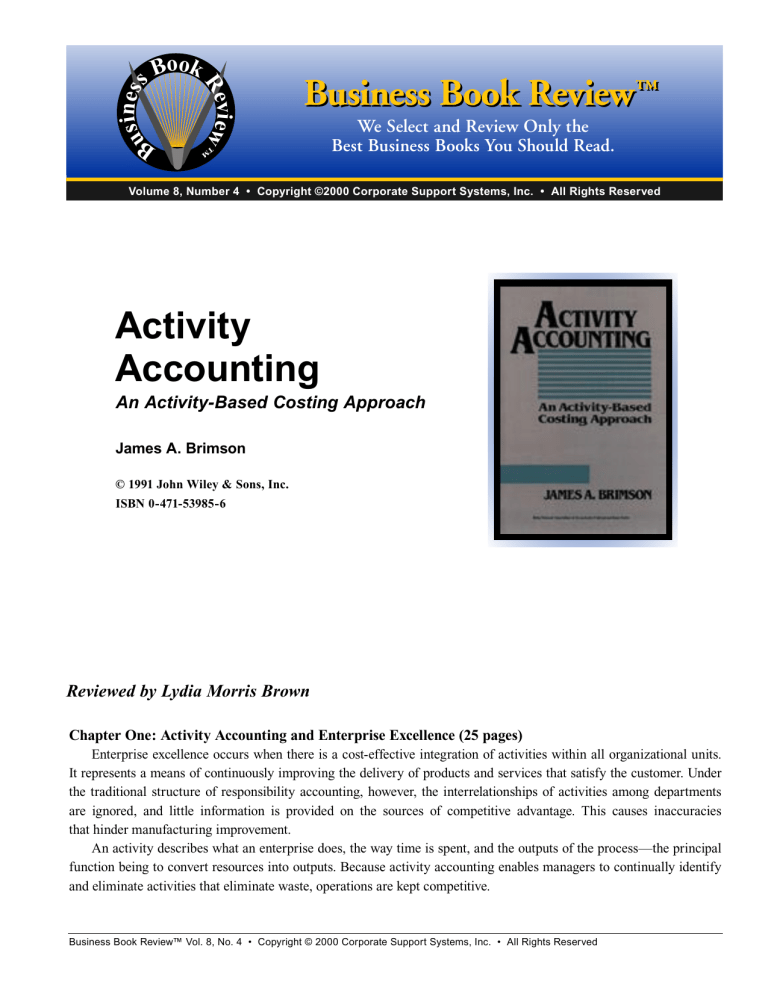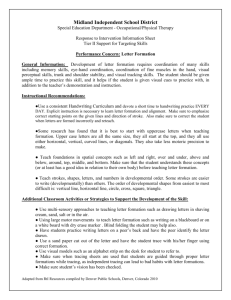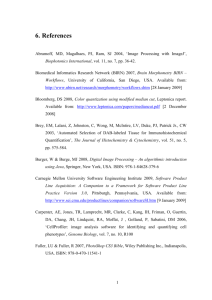Activity Accounting - Faculty and Research

ne si ss
Bu
Book R
evi ew
™
Business Book Review
We Select and Review Only the
Best Business Books You Should Read.
™
Volume 8, Number 4 • Copyright ©2000 Corporate Support Systems, Inc. • All Rights Reserved
Activity
Accounting
An Activity-Based Costing Approach
James A. Brimson
© 1991 John Wiley & Sons, Inc.
ISBN 0-471-53985-6
Reviewed by Lydia Morris Brown
Chapter One: Activity Accounting and Enterprise Excellence (25 pages)
Enterprise excellence occurs when there is a cost-effective integration of activities within all organizational units.
It represents a means of continuously improving the delivery of products and services that satisfy the customer. Under the traditional structure of responsibility accounting, however, the interrelationships of activities among departments are ignored, and little information is provided on the sources of competitive advantage. This causes inaccuracies that hinder manufacturing improvement.
An activity describes what an enterprise does, the way time is spent, and the outputs of the process—the principal function being to convert resources into outputs. Because activity accounting enables managers to continually identify and eliminate activities that eliminate waste, operations are kept competitive.
Business Book Review™ Vol. 8, No. 4 • Copyright © 2000 Corporate Support Systems, Inc. • All Rights Reserved
Activity Accounting
Chapter Two: The Changing Business
Environment (20 pages)
Elimination of waste is now critical to an organization’s success. The primary challenge of managing today’s manufacturing enterprises is to perform all activities correctly the first time; however, the traditional accounting system of the 1920s has increasingly failed to meet that objective. The emergence of cost management systems directly addresses this dilemma. Through activity management the basic functional activities and their interrelationships are readily perceived—thereby, ensuring that the fundamental goals of the enterprise are accomplished.
Chapter Three: Activities, Activity Accounting, and Cost Management (21 pages)
Managing activities must begin with understanding activity cost (the resources assigned to today’s activities), the activity measure (the volume of output), and the performance measure (how well the activity is performed).
Activity accounting accumulates and traces this cost and performance data and provides feedback of actual results compared to projected costs. This kind of system assigns costs as they actually exist at a given point in time, and not as they should or could exist. A cost management system then uses activity cost and performance information to formulate strategic plans and operational decisions and to identify improvement opportunities.
Because they are at an appropriate level of detail, activities rather than tasks form the basis of cost management. Furthermore, it is also useful to characterize an activity by reducing it to its simplest form—the transaction process (resources, inputs, outputs, and procedures). With this approach, it is then possible to set more realistic cost and performance targets derived from the strategic plan; to identify wasteful activities and factors that drive cost; and to improve the quality of pricing, make/buy, and estimating decisions—a function
About the Author
James A. Brimson , a partner with Coopers &
Lybrand Deloitte (U.K.), is considered an expert in cost management, primarily in manufacturing. He is coeditor of Cost Management in an Advanced
Manufacturing Environment.
James A. Brimson of knowing an accurate product cost, derived by tracing the cost of activities to products.
Chapter Four: Why Activities? (11 pages)
There are several characteristics that make activities such a powerful management tool. They:
• Improve product cost accuracy by tracing activities to products on the basis of usage.
• Drive cost—too often cost control focuses on the point of cost occurrence without considering cost drivers.
• Facilitate evaluation of alternatives.
• Focus corporate strategy, enabling a company to determine what it is doing and know how that relates to corporate goals.
• Complement continuous improvement, which has several objectives: elimination of nonvalue added activities; synchronization of lead time vis-a-vis new product introduction and production cycle; increased quality; elimination of process variance; and simplification of activities.
• Are compatible with total quality management.
• Are easily understood by such diverse groups as engineers, operations personnel, accountants, and top management because activities are
“natural” identifiers.
• Link planning and control, integrate financial and nonfinancial performance measures, and improve decision support.
Chapter Five: Activity Analysis (20 pages)
Based on the observation that an entire system is too large to manage but its individual components are not, an activity analysis seeks to provide information concerning what the enterprise does—the specific tasks that make up the job assignment and their relative timing and importance in achieving corporate goals—and the transactions that trigger input and output. No matter what analytical technique is used, the information should include the organization unit; the business process; the factors of production—direct material, labor, and technology; elapsed and process time; value added/non-value added
Business Book Review™ Vol. 8, No. 4 • Copyright © 2000 Corporate Support Systems, Inc. • All Rights Reserved Page 2
Activity Accounting indicators; quality; and inputs/outputs—frequency, unit of measure, sources and destination, and volume.
In order to be used effectively in the decisionmaking process, activity definitions must provide consistent and demonstrably accurate representations of the total enterprise. Although different environments may demand different approaches, the following steps can serve as general guidelines: (1) determine activity analysis scope;
(2) determine activity analysis units; (3) define activities;
(4) rationalize activities as a means of providing a sufficient but not excessive level of detail; (5) classify activities as primary or secondary; (6) create an activity map that identifies the relationship among functions, business processes, and activities; and (7) compile a composite list of activities that support the organizational, business process, and functional analysis requirements.
Chapter Six: Activities of an Industrial
Enterprise (11 pages)
Understanding the typical activities in an industrial enterprise provides an excellent foundation for structuring an activity accounting system. Traditionally, there are five major functions: (1) marketing and sales—main activities include product/product line specification, customer service, developing distribution channels, completing finished goods inventory, product shipping, determining discount policy, product pricing, sales promotion, order processing, and product sale; (2) manufacturing and quality control, including material management, material and supplies procurement, distribution, manufacturing engineering, plant engineering, and machine design; (3) research and development and engineering—the main activities for these functions are new product development, existing product modification, basic research, and R&D processing;
(4) finance and administration—accounting and finance, corporate management, management information systems, development, operations and maintenance, general and administrative management, and personnel; and (5) logistics and field support.
Chapter Seven: Activity Cost (13 pages)
An activity cost is the total expense of all traceable factors of production assigned to perform an activity.
Costs are traceable when the output of an activity can be shown to be directly consumed by another activity or end cost objective. A cost is allocated when it is charged to
Business Book Review™ Vol. 8, No. 4 • Copyright © 2000 Corporate Support Systems, Inc. • All Rights Reserved
James A. Brimson another activity or cost objective on a basis other than direct traceability. An activity’s cost behavior depends on fixedness/variability, influenceability, and flexibility—yet the traditional distinctions between fixed/variable and direct/indirect are secondary to the distinction between traceable/non-traceable. Cost is a function of the capacity of production’s factors and their flexibility to alternative uses. And, whereas the activity measure represents the factor by which the costs of a given process vary most directly, the activity measure is not the cost driver.
Chapter Eight: Calculating an Activity Cost
(31 pages)
Calculating a product cost entails a six-step approach:
(1) selecting cost basis (once chosen, costs must be set at the activity level, must separate the non-value added component of cost, and must identify companywide costs and isolate cost drivers; (2) tracing resources;
(3) determining activity performance measurement, both financial and nonfinancial; (4) selecting activity measure;
(5) allocating secondary activities; and (6) calculating cost per activity.
Chapter Nine: Tracing Activity Cost (16 pages)
Cost is meaningful only when related to an enterprise mission—the final cost objective. After identifying activities and their output, tracing costs to activities, and computing a cost per activity, a company can then identify the users of activities. The point of view depends on the scope and objectives of the cost control or reporting objective, which typically include organizational units, order, cost control units, products, projects, functions, and business processes.
Costs are traced to the final cost objective through a bill of activities which specifies the sequence of activities and the quantity of each activity consumed in achieving such missions as manufacturing a product, providing the manufacturing process, or servicing a customer. The bill of activities manages all activities over the entire life cycle and primarily functions to separate the quantity of an activity from the cost of the activity and to facilitate a mix of different cost behavior patterns when choosing a single allocation basis. The flexibility of this approach permits the cost management system to determine a product cost for a single product.
Page 3
Activity Accounting
Chapter Ten: Activity Product Cost (34 pages)
Products consume activities and materials; thus, an activity product cost system assigns materials and all traceable activities to products based on the usage of each activity. Emphasis is on determining the cost of manufacturing and support processes—product cost is secondary. Direct labor is charged to the process (activity) rather than the product. Because a cost pool is synonymous with an activity, the practice of using a single or limited number of cost pools is eliminated. The direct tracing of activities to products reduces the amount of overhead to be allocated and does not distinguish between direct and indirect costs. And, nonfinancial performance measures are incorporated to judge product performance. Thus, activity accounting provides two important benefits: (1) an accurate product cost, and (2) visibility of cost reduction and performance improvement opportunities. This represents a major change from traditional cost accounting.
James A. Brimson estimating, and pricing decisions that are based on a product cost that represents the manufacturing process; facilitating elimination of waste by providing visibility of non-value added activities; linking corporate strategy to operational decision making; encouraging continual improvement and total quality control; improving the effectiveness of budgeting; improving profitability; and providing insight into overhead—the fastest growing and least visible element of cost. He further contends that if the reader accomplishes only one or two of these objectives, he or she will experience a quantum leap in world-class performance. In this regard, Accounting functions as a primer, providing explicit step-by-step guidelines. Brimson warns, however, that it is “up to you, the reader, to ‘make it happen’.”
* * *
A glossary and subject index are provided.
Reading Suggestions
Reading Time: 5 to 7 hours, 224 Pages in Book
According to the guidelines presented in the Preface, readers with a good background in activity-based accounting can proceed immediately to Chapters Eight and Nine.
Others are, however, advised to start at the beginning and to read the book in its entirety.
Remarks
Presentation
Accounting is definitely not light reading; Brimson provides detailed, explicit explanations and instructions concerning intricate aspects of accounting. He also takes great pains to provide clear, concise definitions and examples. Key points are consistently well highlighted throughout and every concept that appears in the glossary is presented in bold type when it first occurs in the text. Each chapter begins with a list of the purposes of the information presented and ends with a well-focused summary. The many diagrams and charts that appear throughout the book are expertly rendered, as well as simple and direct.
Content
Basically, Accounting advocates a major revolution in accounting practices, urging the overthrow of the old regime for the new. The author identifies a number of benefits of activity accounting: improving make/buy,
Business Book Review™ Vol. 8, No. 4 • Copyright © 2000 Corporate Support Systems, Inc. • All Rights Reserved Page 4
Activity Accounting James A. Brimson
A Note to Our Readers
We at BBR encourage our readers to purchase the business books we review. BBR Reviews are intended as a service to busy professionals, as we recommend only those books that are worth your time to read in their entirety. We apply stringent criteria in selecting only the best business books, and in that selection process, strive to help you make informed book-purchasing decisions.
Business Book Review™ is a service of Business Book Review, LLC
For more information about BBR, past library of book reviews, or to provide us feedback, visit our Web site.
Business Book Review, LLC
1549 Clairmont Road, Suite 205
Decatur, GA 30033
Copyright © 2001 Business Book Review, LLC • All Rights Reserved
No copies may be made of this review unless appropriate license has been granted.
ISSN 0741-8132
To subscribe, contact us at: www.BusinessBookReview.com
Business Book Review™ Vol. 8, No. 4 • Copyright © 2000 Corporate Support Systems, Inc. • All Rights Reserved Page 5




